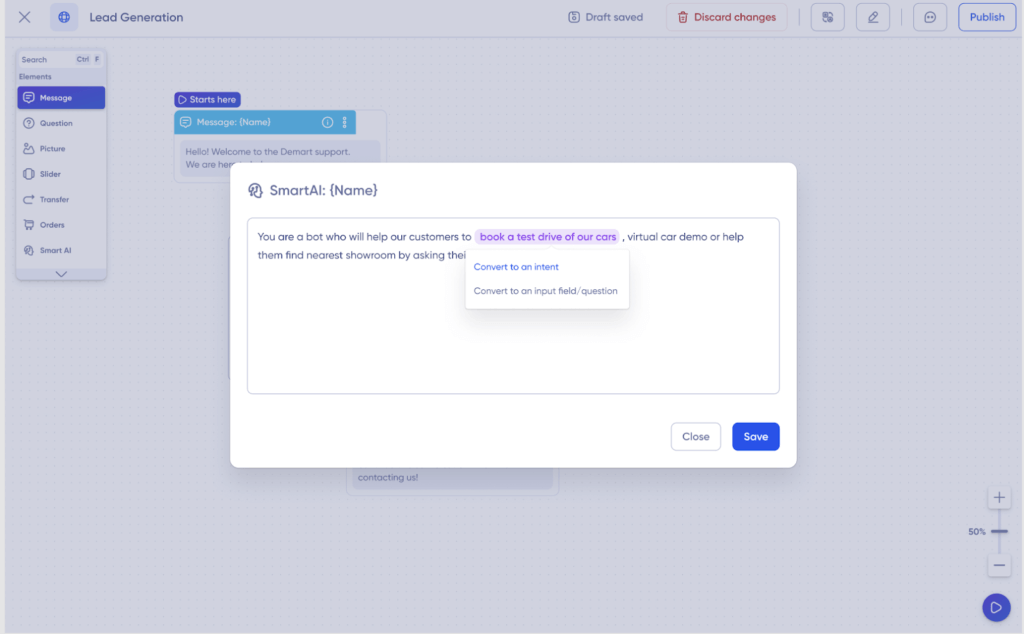Enable Multiple Intent for Prompts in the Smart Block

Enable Multiple Intent for Prompts in the Smart Block
Prompt writing has emerged as a transformative tool across various creative domains, be it content creation, image manipulation, music composition, or video production. Its widespread adoption is driven by its remarkable ability to enhance work efficiency and drastically reduce project timelines with LLM-powered solutions.
By generating insightful prompts, individuals and professionals alike are unlocking new levels of productivity and creativity in their endeavours. This trend signifies a fundamental shift in how we approach and accomplish tasks in today’s fast-paced digital landscape. A few weeks back, we launched the Smart Block, using which you can just jot down prompts to create conversation flows.
Introducing Phase Two of the Smart Block!
This enhancement enables even more dynamic conversation flow creation, resulting in contextually aware interactions that reduce repetition for a smoother engagement.
What is Multiple Intent in Prompts?
Intent is basically the purpose or the goal of the conversation. By converting words into intents, users can streamline information flow across recipe blocks, minimising the need for repetitive queries.
This enhancement enables the system to seamlessly transmit and interpret intents in the following block, greatly improving contextual understanding. Consequently, this facilitates the creation of more meaningful and fluid interactions, resulting in an improved overall customer experience.
Users can also add questions/fields that they want customers to answer to enable the intent or the purpose of the conversation flow, which can be used by the following blocks to converse with the customer and avoid repetitive questions.
Let us see an example.
Example Prompt:
If the customer is ready to purchase a new car, ask for preferences, such as the brand, model, and colour of the car.
In the above example,
- A new car can become an intent of the conversation
- Preferences – Output/question
- Brand – Output/question
- Model – Output/question
- Colour – Output/question
New prompt becomes: If the customer is ready to purchase a new car (intent), ask for preferences, such as the brand(output, mandatory), model(output, mandatory), and colour(output, optional), of the car.
Here the intent is “purchasing a car”, and brand, model and color are the questions and input fields needed for enabling the intent of the conversation– buying a car.
How to Convert Words into Prompts?
Designate the words you wish to transform into intents and its corresponding questions, which will transfer to the subsequent block.

The intent within the prompt will be highlighted in purple.
The input/question field will be marked in blue.
You can even configure the intents and fields by adding variables and associated intents.
What are the Benefits?
Here are the benefits of multiple intents in the Smart Block:
Enhanced Conversational Flow
This feature allows for a more dynamic and context-aware conversation, improving the overall interaction between the bot and the user.
Reduction in Repetitive Questions
By recognizing multiple intents within a prompt, the bot can avoid asking repetitive questions, leading to a smoother and more engaging interaction.
Improved User Experience
With the reduction in repetitive questions, users will have a more seamless experience, which can positively impact metrics like bot deflection rate, NPS, and CSAT scores.
Empowered Bots
Bots can now pass recognised intents to the next block, enabling a more sophisticated understanding of user queries and responses.
Dynamic Responses
With the ability to recognise multiple intents, the solution can provide more relevant and context-specific responses, making the conversation feel more natural and intuitive.
Customisation and Personalisation
Conditional questions linked to specific intents allow for tailored responses, making the conversation feel more personalised for each user.
Efficient Information Collection
By asking questions based on recognised intents, the solution can efficiently collect the necessary information from the user, streamlining the interaction.
Improved Bot Performance
This feature empowers the solution to make better use of gathered information, ultimately leading to more accurate and relevant responses without having to ask repetitive questions or seek human support. Thus, improving the bot deflection rates.
Versatile Application
Multiple intents in prompts can be applied across various industries and scenarios, making it a versatile tool for creating engaging conversational experiences.
By leveraging this feature, users can unlock a new level of sophistication in their conversational AI applications, leading to more effective and satisfying interactions.
Smart Conversations for Smart Users
Incorporating this feature into your workflow unlocks a multitude of benefits. Conversations become dynamic and context-aware, greatly enhancing the interaction between the solution and the user. The reduction in repetitive questions results in a smoother user experience, positively impacting key metrics like bot deflection rate, NPS, and CSAT scores.
Empowered conversational AI can now seamlessly pass recognized intents to the next block, leading to a more sophisticated understanding of user queries and responses. Responses are more relevant and context-specific, creating a natural and intuitive conversation. This level of customisation and personalisation makes each interaction feel tailored to the individual user.
Learn more about the functioning of this feature here.







